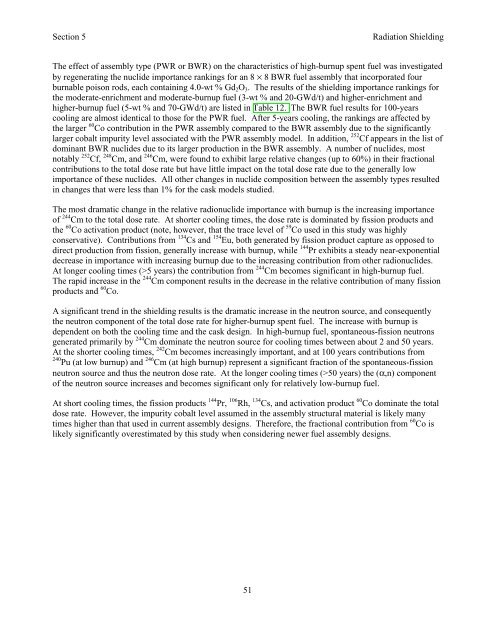nureg/cr-6700 - Oak Ridge National Laboratory
nureg/cr-6700 - Oak Ridge National Laboratory
nureg/cr-6700 - Oak Ridge National Laboratory
Create successful ePaper yourself
Turn your PDF publications into a flip-book with our unique Google optimized e-Paper software.
Section 5<br />
Radiation Shielding<br />
The effect of assembly type (PWR or BWR) on the characteristics of high-burnup spent fuel was investigated<br />
by regenerating the nuclide importance rankings for an 8 × 8 BWR fuel assembly that incorporated four<br />
burnable poison rods, each containing 4.0-wt % Gd 2 O 3 . The results of the shielding importance rankings for<br />
the moderate-enrichment and moderate-burnup fuel (3-wt % and 20-GWd/t) and higher-enrichment and<br />
higher-burnup fuel (5-wt % and 70-GWd/t) are listed in Table 12. The BWR fuel results for 100-years<br />
cooling are almost identical to those for the PWR fuel. After 5-years cooling, the rankings are affected by<br />
the larger 60 Co contribution in the PWR assembly compared to the BWR assembly due to the significantly<br />
larger cobalt impurity level associated with the PWR assembly model. In addition, 252 Cf appears in the list of<br />
dominant BWR nuclides due to its larger production in the BWR assembly. A number of nuclides, most<br />
notably 252 Cf, 248 Cm, and 246 Cm, were found to exhibit large relative changes (up to 60%) in their fractional<br />
contributions to the total dose rate but have little impact on the total dose rate due to the generally low<br />
importance of these nuclides. All other changes in nuclide composition between the assembly types resulted<br />
in changes that were less than 1% for the cask models studied.<br />
The most dramatic change in the relative radionuclide importance with burnup is the in<strong>cr</strong>easing importance<br />
of 244 Cm to the total dose rate. At shorter cooling times, the dose rate is dominated by fission products and<br />
the 60 Co activation product (note, however, that the trace level of 59 Co used in this study was highly<br />
conservative). Contributions from 134 Cs and 154 Eu, both generated by fission product capture as opposed to<br />
direct production from fission, generally in<strong>cr</strong>ease with burnup, while 144 Pr exhibits a steady near-exponential<br />
de<strong>cr</strong>ease in importance with in<strong>cr</strong>easing burnup due to the in<strong>cr</strong>easing contribution from other radionuclides.<br />
At longer cooling times (>5 years) the contribution from 244 Cm becomes significant in high-burnup fuel.<br />
The rapid in<strong>cr</strong>ease in the 244 Cm component results in the de<strong>cr</strong>ease in the relative contribution of many fission<br />
products and 60 Co.<br />
A significant trend in the shielding results is the dramatic in<strong>cr</strong>ease in the neutron source, and consequently<br />
the neutron component of the total dose rate for higher-burnup spent fuel. The in<strong>cr</strong>ease with burnup is<br />
dependent on both the cooling time and the cask design. In high-burnup fuel, spontaneous-fission neutrons<br />
generated primarily by 244 Cm dominate the neutron source for cooling times between about 2 and 50 years.<br />
At the shorter cooling times, 242 Cm becomes in<strong>cr</strong>easingly important, and at 100 years contributions from<br />
240 Pu (at low burnup) and 246 Cm (at high burnup) represent a significant fraction of the spontaneous-fission<br />
neutron source and thus the neutron dose rate. At the longer cooling times (>50 years) the (α,n) component<br />
of the neutron source in<strong>cr</strong>eases and becomes significant only for relatively low-burnup fuel.<br />
At short cooling times, the fission products 144 Pr, 106 Rh, 134 Cs, and activation product 60 Co dominate the total<br />
dose rate. However, the impurity cobalt level assumed in the assembly structural material is likely many<br />
times higher than that used in current assembly designs. Therefore, the fractional contribution from 60 Co is<br />
likely significantly overestimated by this study when considering newer fuel assembly designs.<br />
51

















